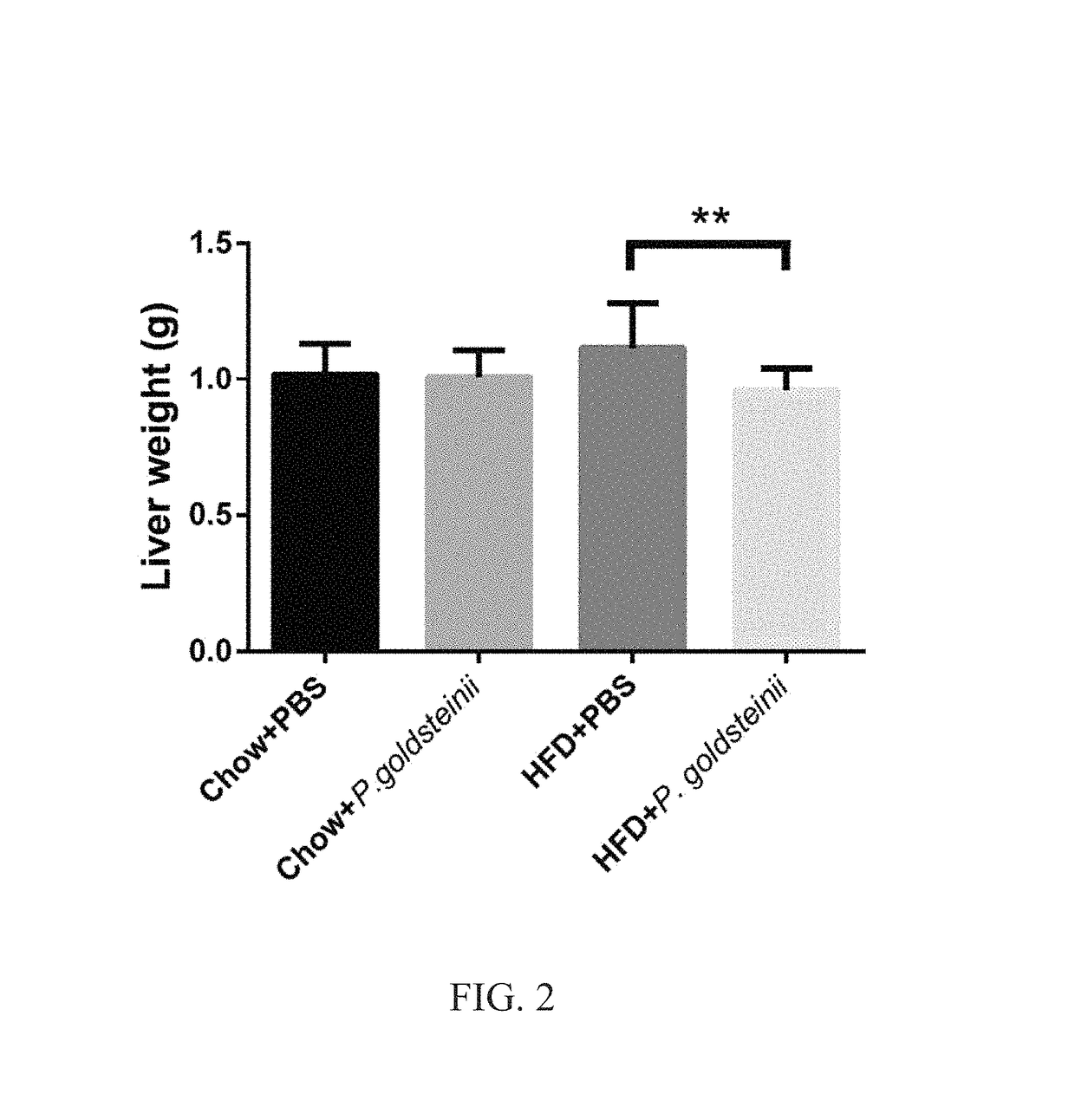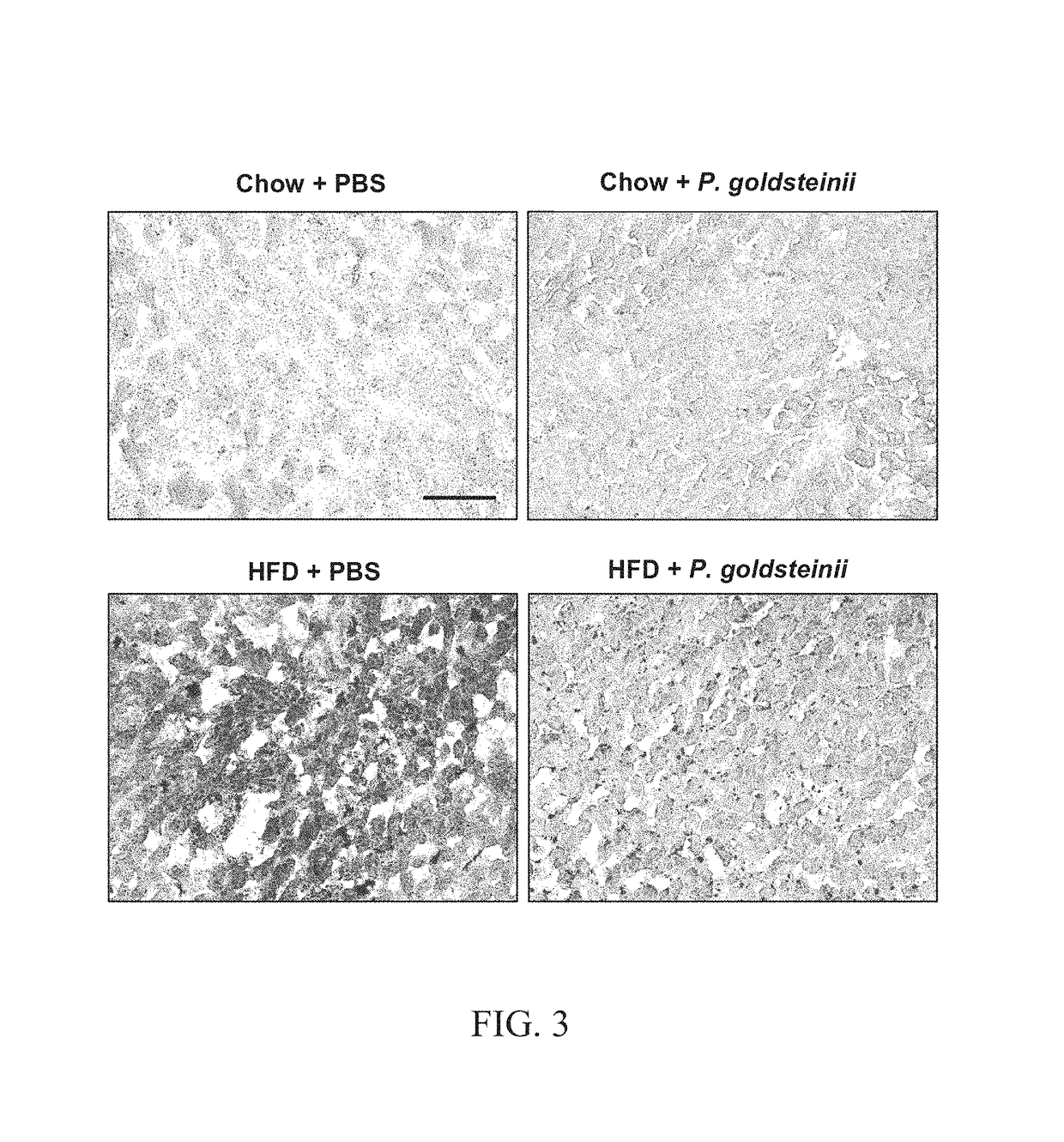Method to treat fatty liver disease using Parabacteroides goldsteinii
a technology of parabacteroides goldsteinii and liver disease, which is applied in the field of treating fatty liver disease, can solve the problems of dangerous conditions in which the liver no longer functions properly, no pharmaceutical drugs have been specifically approved for the treatment of fatty liver disease, and liver fibrosis and cirrhosis, etc., and achieve the effects of reducing liver weight, liver lipid accumulation and hepatocyte hypertrophy, and reducing blood aspartate aminotransferas
- Summary
- Abstract
- Description
- Claims
- Application Information
AI Technical Summary
Benefits of technology
Problems solved by technology
Method used
Image
Examples
example 1
Effects of P goldsteinii Bacterium Treatment on Blood AST Level in HFD-Fed Mice
[0023]Eight-week old C57BL / 6J male mice were fed with standard chow (13.5% of energy from fat; LabDiet 5001; LabDiet, USA) in the control group or with HFD (60% of energy from fat; TestDiet 58Y1; TestDiet, USA) in the experimental group. The mice were also treated daily with 200 μl of P. goldsteinii ATCC strain BAA-1180 (2×106 CFUs) or PBS for 8 weeks by intragastric gavage (n=10 mice / group). The mice were assigned to four groups: (1) mice fed with standard chow and treated with phosphate buffered saline (Chow+PBS); (2) mice fed with standard chow and treated with P. goldsteinii (Chow+P. goldsteinii); (3) mice fed with HFD and treated with PBS (HFD+PBS); and (4) mice fed with HFD and treated with P. goldsteinii (HFD+P. goldsteinii).
[0024]After 8 weeks, blood samples were collected from each mouse, and AST level was quantified using a biochemical analyzer (Hitachi 7080, Hitachi, Japan). Data were presented...
example 2
Effects of P. goldsteinii Bacterium Treatment on Liver Weight in HFD-Fed Mice
[0026]Eight-week old C57BL / 6J male mice were treated as in Example 1 and assigned to four groups consisting of Chow+PBS, Chow+P. goldsteinii, HFD+PBS and HFD+P. goldsteinii. After 8 weeks, liver tissues from each mouse were dissected and weighted. Data were presented as means±standard deviation (n=10 mice / group) and analyzed using one-way ANOVA followed by Bonferroni post hoc test (**P<0.01).
[0027]FIG. 2 shows the effects of P. goldsteinii on liver weight. HFD feeding (HFD+PBS) for 8 weeks increased liver weight compared to feeding with chow (Chow+PBS). By contrast, supplementation with P. goldsteinii (HFD+P. goldsteinii) reduced liver weight in a statistically significant manner compared to the HFD group (HFD+PBS) indicating that the P. goldsteinii treatment described in the present n has the effect of reducing liver weight in a subject in need thereof.
example 3
Effects of P. goldsteinii Bacterium Treatment on Lipid Accumulation in the Liver of HFD-Fed Mice
[0028]Eight-week old C57BL / 6J male mice were treated as in Example 1 and assigned to four groups (Chow+PBS, Chow+P. goldsteinii, HFD+PBS and HFD+P. goldsteinii). After 8 weeks, liver tissues from each mouse were dissected and frozen to prepare tissue sections. Frozen liver sections (6-μm thick) were stained with oil red O (Sigma, USA), and counter-stained with haematoxylin for 1 min. Sections were then examined under light microscopy (scale bar, 100 μm).
[0029]FIG. 3 shows the effects of P. goldsteinii supplementation on lipid accumulation in the liver. While HFD feeding (HFD+PBS) increased lipid accumulation in the liver compared to feeding with chow (Chow+PBS), the P. goldsteinii treatment (HFD+P. goldsteinii) reduced hepatic lipid accumulation compared to the HFD group (HFD+PBS), indicating that the P. goldsteinii treatment disclosed in the present invention reduces lipid accumulation i...
PUM
| Property | Measurement | Unit |
|---|---|---|
| thick | aaaaa | aaaaa |
| body weight | aaaaa | aaaaa |
| weight | aaaaa | aaaaa |
Abstract
Description
Claims
Application Information
 Login to View More
Login to View More - R&D
- Intellectual Property
- Life Sciences
- Materials
- Tech Scout
- Unparalleled Data Quality
- Higher Quality Content
- 60% Fewer Hallucinations
Browse by: Latest US Patents, China's latest patents, Technical Efficacy Thesaurus, Application Domain, Technology Topic, Popular Technical Reports.
© 2025 PatSnap. All rights reserved.Legal|Privacy policy|Modern Slavery Act Transparency Statement|Sitemap|About US| Contact US: help@patsnap.com



